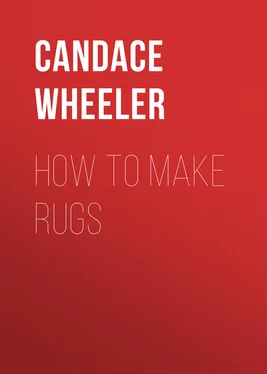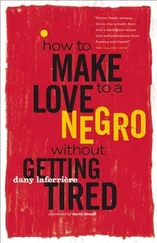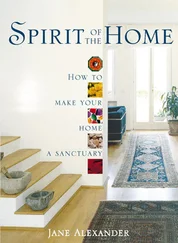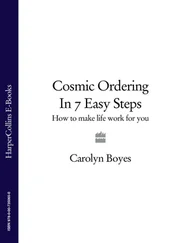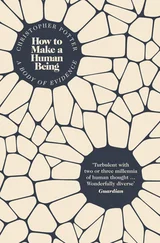Candace Wheeler - How to make rugs
Здесь есть возможность читать онлайн «Candace Wheeler - How to make rugs» — ознакомительный отрывок электронной книги совершенно бесплатно, а после прочтения отрывка купить полную версию. В некоторых случаях можно слушать аудио, скачать через торрент в формате fb2 и присутствует краткое содержание. Жанр: foreign_antique, foreign_home, Технические науки, на английском языке. Описание произведения, (предисловие) а так же отзывы посетителей доступны на портале библиотеки ЛибКат.
- Название:How to make rugs
- Автор:
- Жанр:
- Год:неизвестен
- ISBN:нет данных
- Рейтинг книги:4 / 5. Голосов: 1
-
Избранное:Добавить в избранное
- Отзывы:
-
Ваша оценка:
- 80
- 1
- 2
- 3
- 4
- 5
How to make rugs: краткое содержание, описание и аннотация
Предлагаем к чтению аннотацию, описание, краткое содержание или предисловие (зависит от того, что написал сам автор книги «How to make rugs»). Если вы не нашли необходимую информацию о книге — напишите в комментариях, мы постараемся отыскать её.
How to make rugs — читать онлайн ознакомительный отрывок
Ниже представлен текст книги, разбитый по страницам. Система сохранения места последней прочитанной страницы, позволяет с удобством читать онлайн бесплатно книгу «How to make rugs», без необходимости каждый раз заново искать на чём Вы остановились. Поставьте закладку, и сможете в любой момент перейти на страницу, на которой закончили чтение.
Интервал:
Закладка:
This small book is intended as a help in adapting their work to modern demands, as well as to open a new field to the farmer’s family during the winter months, when their time is not necessarily occupied with growing and securing crops.
WEAVING
It does not undertake to teach any one who buys or has inherited a loom to begin weaving without any further preparation. The warping or threading of it must be seen to be understood, but when that is once learned, all of the rest is a matter of practice and experiment, and is really no more difficult than any other domestic art. One would not expect to spin without being shown how to pull the wool and turn the wheel at the same time, or even to sew or knit without some sort of instruction, and the same is true of weaving.
There are many old looms still to be found in the garrets of farmhouses, and where one has been inherited it is best to begin learning to weave upon it instead of substituting a new one, since the same knowledge answers for both. Probably some older member of the family, or at least some old neighbour, will be able to teach the new beginner how to set up the loom and to proceed from that to actual weaving. After this is learned it rests with one’s self to become a good weaver, a practical dyer, and to put colors together which are both harmonious and effective.
What I have chiefly tried to show is how to get proper materials and how to use them to the best advantage. I think it is safe to say that no domestic art is capable of such important results from a pecuniary point of view, or so important an extension in the direction of practical art. Where it is used as an art-process and an interesting occupation, by women of leisure, it is capable of the finest results, and there is no reason why these results should not become a matter of business profit.
Rag carpets have generally been woven of rags cut from any old garments cast aside by the household—coats and trousers too old for patching, sheets and pillow-cases too tender to use, calico, serge, bits of woolen stuffs old and new, went into the carpet basket, to be cut or torn into strips, sewed indiscriminately together, and rolled into balls until there should be enough of them for the work of the loom. When this time came the loom would be warped with white cotton or purple yarn, dyed with “sugar paper” or logwood, and the carpet woven. Even with this entire carelessness as to any other result than that of a useful floor covering, the rag carpet, with its “hit or miss” mixture, was not a bad thing; and a very small degree of attention has served to give it a respectable place in domestic manufactures. But it is capable of being carried much farther; in fact, I know of no process which can so easily be made to produce really good and beautiful results as rag carpet weaving.
The first material needed is what are called carpet warps, and these can be purchased in different weights and sizes and more or less reliable colours in every country store, this fact alone showing the prevalence of home weaving, since the yarns are not—at least to my knowledge—used for any other purpose.
The cost of warp, dyed or undyed, depends upon the quantity required, or, in other words, upon its being purchased at wholesale or retail. At retail it costs twenty cents per pound, and at wholesale sixteen. To buy of a wholesale dealer one must be able to order at least a hundred pounds, and as this would weave but a hundred and fifty rugs it would not be too large a quantity to have on hand for even a moderate amount of weaving. These prices refer only to ordinary cotton warps, and not to fine “silk finish,” to linen, or even to silk ones, each of which has its special use and price.
In all of them fast colour is a most desirable quality, and, indeed, for truly good work a necessity. I have found but two of the colours which are upon ordinary sale to be reasonably fast, and those are a very deep red and the ordinary orange. The latter will run when dipped in water; in fact, it will give out dye to such good purpose that I have sometimes used the water in which it has been steeped to dye cotton rags, as it gives a very good and quite fast lemon yellow.
It follows, then, that in weaving rugs (which must be washable) with orange warp, the warp must be steeped in warm water before using. It can be used in that state, or it can be set with alum, or it can be dipped in a thin indigo dye and made into a good and fast green.
The only recourse of the domestic weaver who wishes to establish her rugs as of the very best make is to dye her own warps; and this is not only an easy but a most interesting process; so much so, in fact, that I am tempted to enlarge upon it as a practical study for the young people of the family. It is necessary at the very beginning to put much stress upon the value of fast colour in the warping yarn, since a faded warp will entirely neutralize the colour of the rags, and spoil the beauty of the most successful rug.
The most necessary and widely applicable colour needed in warps, or, indeed, in rags, is a perfectly fast blue in different depths, and this can only be secured by indigo. Aniline blue in cotton is never sun-fast and rarely will stand washing, but a good indigo blue will neither run or fade, and is therefore precisely what is needed for domestic manufacture. Fortunately, the dye-tub has been, in the past at least, a close companion of the loom, and most old-fashioned farmers’ wives know how to use it. With this one can command reliable blue warps of all shades; and when we come to directions for making washable rugs its importance will be seen.
As I have said, by dipping orange warp in medium indigo blue a fast and vivid green can be secured, and these two tints, together with orange and red, give as many colours as one needs for rug weaving; they give, in fact, a choice of five colours—orange, red, blue, green and white. Orange and red are both colours which can be relied upon when prepared from the ordinary “Magic” dyes of commerce. Turkey red especially is safe to last, even when applied to cotton. In the general disapproval of mineral dyes, this one may certainly be excepted, as well as the crimson red known as “cardinal,” which is both durable and beautiful, in silk or woolen fibre or texture.
After good warps are secured, the second material needed is filling ; and here the subject of old and new rags is to be considered. Of course, cloth which has served other purposes, as in sheets, pillow-cases, curtains, dress skirts, etc., is still capable of prolonged wear when the thin parts are removed and those which are fairly strong are folded and bunched into carpet filling; and for family use, or limited sale, such rags—dyed in some colour—are really desirable. Good varieties of washable rugs can be made of half-worn cotton without dyeing (although they will not be as durable as if made from unworn muslin) by using blue warps to white fillings. The colour effects and methods of weaving will be the same whether old or new rags are used; but in making a study of rag rug weaving from the point of view of building up an important industry, it is necessary to consider only the use of new rags and how to procure the best of them at the cheapest rates.
There is a certain amount of what is called waste in all cloth mills, either cotton, wool or silk, and also in the manufacture of every kind of clothing. The waste from cotton mills, consisting for the most part of “piece ends,” imperfect beginnings or endings, which must be torn off when the piece is made up, are exactly suitable for carpet weaving; and, in fact, if made for the purpose could hardly be better. These can be bought for from ten to twelve cents per pound. The same price holds for ginghams and for coloured cottons of various sorts.
Читать дальшеИнтервал:
Закладка:
Похожие книги на «How to make rugs»
Представляем Вашему вниманию похожие книги на «How to make rugs» списком для выбора. Мы отобрали схожую по названию и смыслу литературу в надежде предоставить читателям больше вариантов отыскать новые, интересные, ещё непрочитанные произведения.
Обсуждение, отзывы о книге «How to make rugs» и просто собственные мнения читателей. Оставьте ваши комментарии, напишите, что Вы думаете о произведении, его смысле или главных героях. Укажите что конкретно понравилось, а что нет, и почему Вы так считаете.
